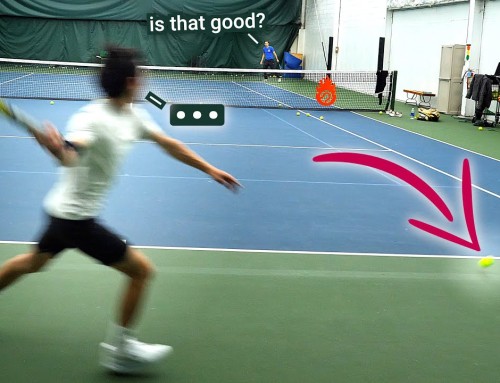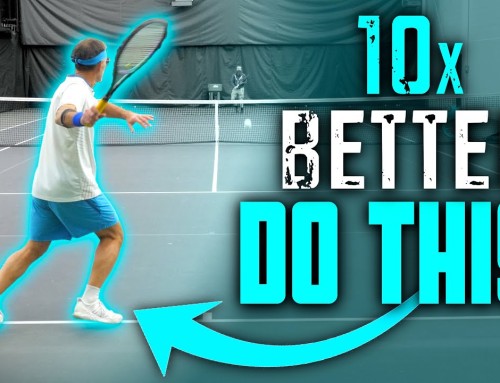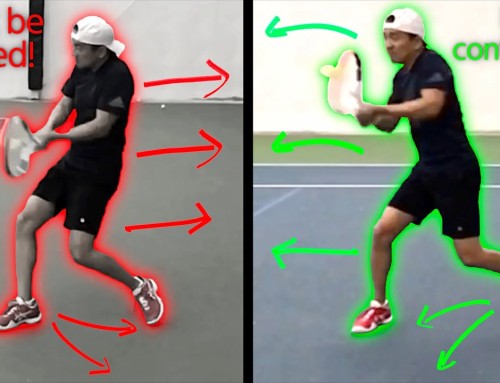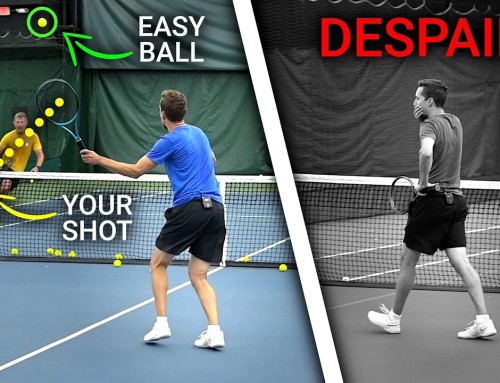Take your game one step further by grabbing this 4 page Action Plan and get Step-by-Step directions to avoiding these mistakes today.
You are making 3 of the biggest mistakes in tennis. How do I know? Because from the beginner level to the best in the world, everyone makes these mistakes. The good news? You can combat these mistakes and become a better player by becoming aware of them and working to make them happen less and less.
Mistake #1: Mis-hitting the Ball
Shanking, mis-hitting, hitting off center – whatever you call it, this mistake is happening way more frequently than you think. It’s important to hit “clean,” in the middle of your racquet because when we fail to do so, the racquet will twist in the hand and we lose control of what we want the ball to do. In order to lessen the amount that you mishit, it’s important to know when it happens, where it happens, and what to do about it. There are 3 different ways to tell if you’ve mishit a ball. They are:
Sound
Feel
What happens to the ball as it comes off your racquet
To overcome this, there are 2 drills to start off with.
Drill #1:
Bounce the ball up and down in the air on your strings, maintaining it in the middle. Once you can successfully keep the ball going in the air, then purposefully move the ball off the center of the racquet. As the ball bounces farther from the center, make mental note of what it feels like in your hand. The ball’s bounce will become more erratic, even “dead” if it bounces very close to the frame. Don’t try to adjust for it by squeezing tighter, keep the hand relaxed so that you can experience this feeling.
Drill #2:
Use a ball machine or have a partner feed volleys to you at the net. Purposefully aim off center to dial in your judgment and to feel what it’s like to hit the ball on the outside edge. The racquet will twist in your hand as you hit off the center of the strings. Pick a place on your racquet to hit each time. For example, you could aim for the “upper outer left” side of your strings and see what happens. Keep that hand relaxed and see if the ball is hit as effectively as you had intended. Eventually you’ll be able to identify where you hit the ball if you mishit and will be able to make adjustments as they come. Finally, aim to hit the ball in the middle of your racquet. As you strive for a clean hit, the execution will feel so much better.
Mistake #2: Split Step
The vast majority of amateur players do not set themselves up for success from the beginning of the point – and don’t even know it! If you watch for differences between lower level players and higher level players, you will see that higher level players seem to have an uncanny ability to be in the right place at the right time. You will also notice that the higher level players always split step, whereas chances are that a split step is nowhere to be seen on a lower level player’s court.
The split step is the foundation for all footwork in tennis. A split step is a small hop on the balls of our feet that puts us in balance for the incoming ball. A proper split step should be made with feet about shoulder-width apart so that we create an athletic base in order to set ourselves up to move in any direction for the next ball. To practice your split step, check out the following drills:
Drill #1:
Timing the split step is key. The most effective time to split is right as your opponent makes contact with the ball. So, watch a tennis match (in person, on your TV, or device) and split step every single time the ball is struck.
Another way of doing this is to pretend that you are one of the players on the court as you watch the match. Every time your “opponent” makes contact, split step. Notice every time if you are a little early or late so that you can adjust for the next ball.
Drill #2:
Now on a tennis court, focus on nothing else but your split step. Starting at the service line, rally back and forth with a partner. Keep your eyes focused on when they make contact with each hit and split step every time. The balls of your feet should hit the ground at the same time they make contact.
When you implement this skill into your practice, you might begin to notice that you have more time than usual. This is true because you will be in a better position on the court, you’ll be more focused on what your opponent’s racquet is doing, and your ability to anticipate will heighten over time – truly setting yourself up for success!
Mistake #3: Tension
Tension is a killer! Not only does it limit your potential power, spin, and accuracy in tennis but it also can lead to serious injuries (i.e. tennis elbow!)
Most players have unnecessary strength or grip in the racquet handle, which leads to too much tension in the forearm and shoulder. This tension limits the movement from the rest of our body, often forcing an abrupt stop in the swing. To overcome tension, check out this exercise:
Drill #1:
For this drill, you will need a racquet with no strings and your regular racquet with strings. Have a ball machine or partner feed you a ball and try to hit a forehand with the racquet with no strings. Right after you hit, identify where in the swing you felt tension. Was it in your forearm? Your shoulder? Elsewhere?
Focus on that spot of your body and with each swing, try to lessen the tension you feel. Relax your hand, relax your arm, and do your best to make smooth swings. With each repetition, make it your goal to make the tension less. If you would rate your tension an “8” on one swing, then see if you can make it a “7” on the next one.
Now pick up your regular racquet with strings in it and start to identify if you feel tension still. Again, relax more with each swing. Do your best to replicate the feeling of looseness and relaxation as you did with the stringless racquet to create smooth swings every time. By doing this, you will get more out of your swing with less effort. This is where we get the phrase “easy power.”
Take your game one step further by grabbing this 4 page Action Plan and get Step-by-Step directions to avoiding these mistakes today.






